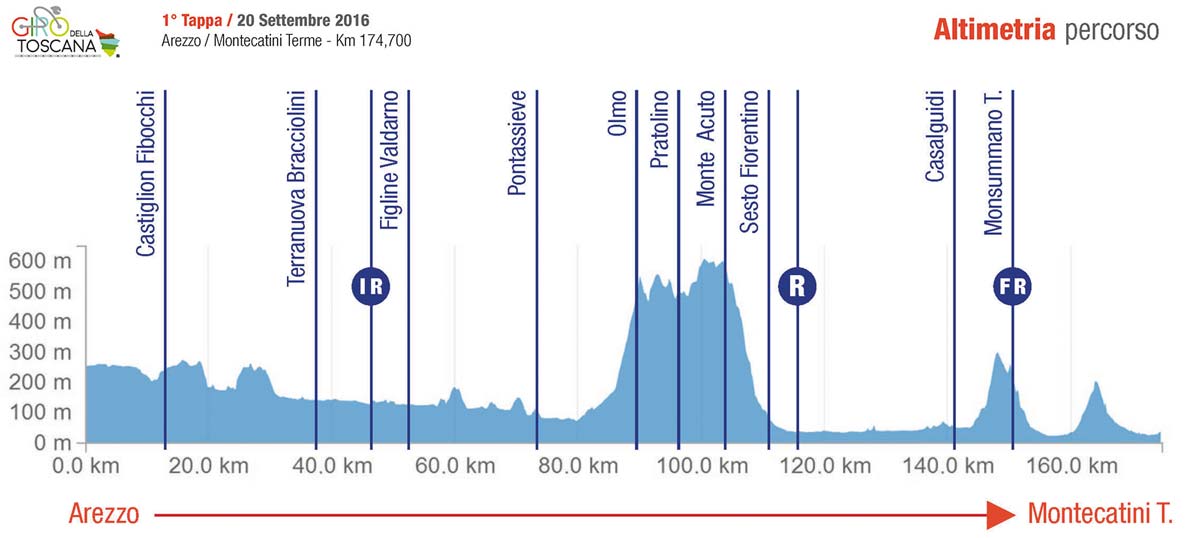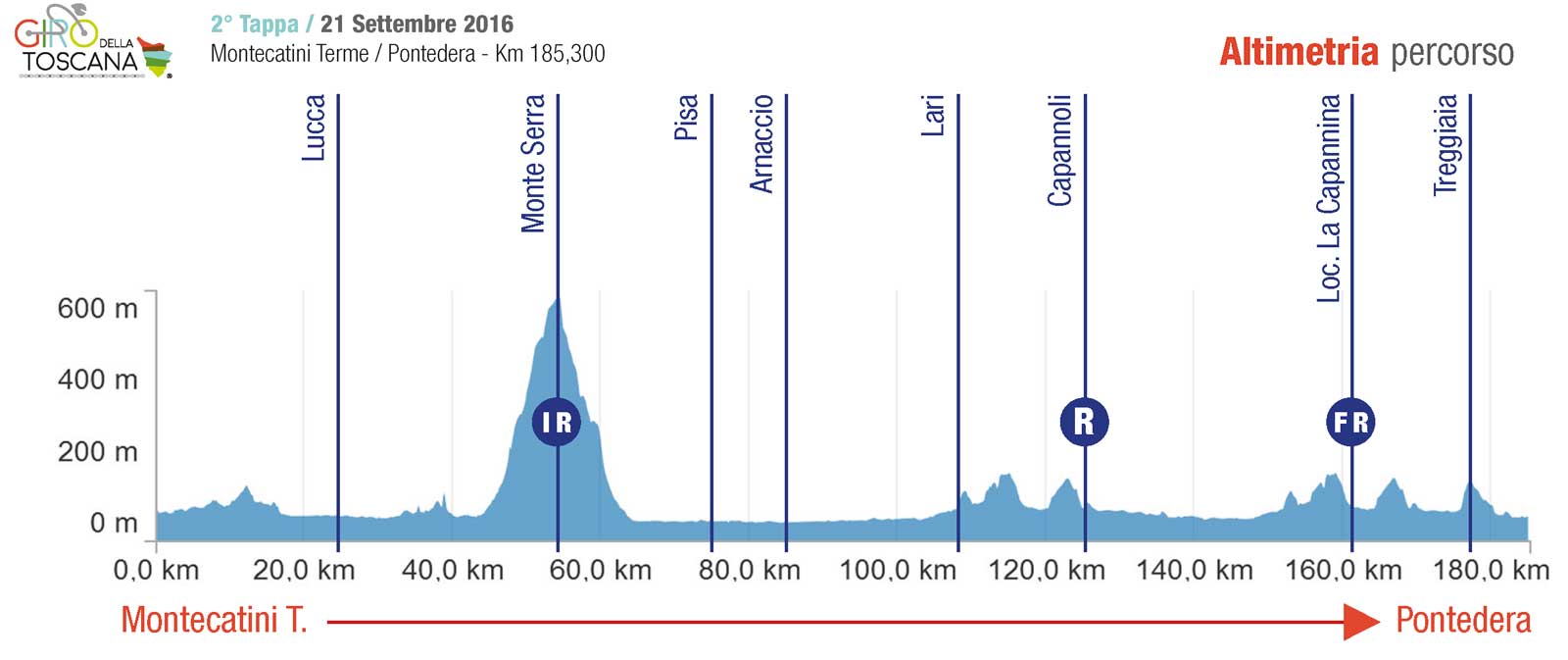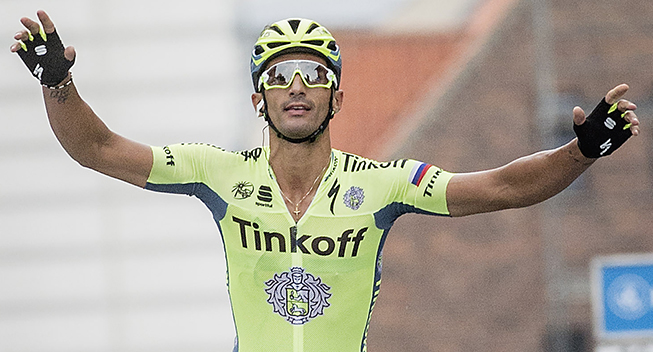The Italian one-day scene is no longer what it once was but one part of the calendar still flourishes. The famous series of autumn classics in Italy is still very rich and until October 1 when it all culminates at Il Lombardia, no less than 11 relatively big races will be held in the country. One race has even bucked the negative trend of recent years as the one-day race Giro della Toscana has grown into a two-day stage race and for its first edition in the new format, it has attracted a very competitive field that will be ready to battle it out on an interesting course suited to strong sprinters.
Being one of cycling’s traditional key countries, Italy once had a very rich calendar of one-day races. Both the spring and the autumn were loaded with great classics in some of the best cycling terrain in the world. Classics riders with a good punch on the climbs and a fast finish excelled on the lumpy courses of the many race in one of cycling’s main countries.
Unfortunately, the tough economic times have taken its toll on the calendar and now there are barely any races left in the first part of the year. The only one-day races in February are GP Costa degli Etruschi and Trofeo Laigueglia, only Strade Bianche and GP Industria have survived on the March calendar and in April, there is just the Giro dell’Appennino left. Trofeo Matteotti is held in July and there is no longer a single race in August which was once one of the busiest months on the calendar.
However, the autumn classics have mostly managed to survive. In fact, no country can boast such a rich amount of big one-day races at any time of the year as Italy can in the months of September and October. No less than 1p 1.1, 1.HC and WorldTour races make up an intriguing and exciting part of the cycling season that plays a special role and is dear to many riders’ heart. The highlight if of course the monument Il Lombardia which has traditional been the final event in the series. In recent years, a reshuffling of the calendar has moved it a bit forward in the calendar and the weekend with the Giro dell’Emilia and GP Beghelli has brought the curtain down on the Italian season. This year the new date for the Worlds means that those races will be held earlier than usual, and Il Lombardia will again be the final race in the series. Hence, all 11 races will take place between September 14 and October 1, turning it into the busiest period in any cycling country during the year.
The many one-day races play a special role for many Italian riders. The first races have traditionally been the final key events for the national coach to finalize his selection for the World Championships, and very often the national team has lined up in some of the races that have served as some kind of a dress rehearsal. The later events have formed their own block with a busy week of hilly races that work serve as perfect preparation for Il Lombardia. That block includes Milan-Turin and Gran Piemonte which are organized by RCS Sports and those races have a much more international flavor than the early races which are mainly dominated by Italians.
Last week the series kicked off with Coppa Bernocchi, Coppa Agostoni and Memorial Marco Pantani and this week things get even more intense as there will be racing on Tuesday, Wednesday, Thusday, Saturday and Sunday. The opening event is a novelty on the calendar. Since 1923, the Giro della Toscana has been held almost every year and it has been a treasured one-day race on the Italian calendar. With a winner’s list that includes the likes of Costante Girardengo, Alfredo Binda, Gno Bartali, Fiorenzo Magni, Rudi Altig, Roger De Vlaeminck, Francesco Moser, Maurizio Fondriest, Vincenzo Nibali, Alessandro Petacchi, Daniel Martin and Alessandro Ballan, it has been won by some of cycling’s biggest names which speaks volumes about its importance. Being the big regional race in one of the most cycling-mad regions in Italy, it is no surprise that it has been a key event for most of the past century.
Like most other Italian races, the organizers have had a hard time keeping the race alive and it was even cancelled in 2015. However, just as it looked like it was going to disappear, things changed completely. This year the race is back on the calendar and it has even been extended to a two-day stage race, thus bucking the negative trend completely. Held over two days before the Coppa Sabatini, those two races have now teamed up to form a solid three-day block held by the same organizers and they have had great success in attracting a solid field for their first year with the new format.
The Giro della Toscana has never had a fixed course as it has visited different places in the region. That is reflected in a winner’s list that includes riders like Vincenzo Nibali and Daniel Martin in addition to sprinters like Mattia Gavazzi and Alessandro Petacchi. The Tuscan geography gives the chance to create almost any kind of race and for their first edition as a stage race, the organizers have opted for a course suited to fast finishers. Both stages have flat finales but also include a significant amount of climbing which means that it looks like the perfect event for strong sprinters who could get a rare chance to go for victory in a stage race.
In a year when the World is suited to fast finishers, that decision is no surprise and for many riders the three days in Italy is a solid alternative to the Eneco Tour as they ramp up their form for the race in Qatar. Most importantly, the organizers have managed to attract Mark Cavendish who has made a late change to his plans and will use the Giro della Toscana to fine-tune his condition. As usual, the Italian national team will also be present and even though they will be without their leaders in Qatar – Giacomo Nizzolo or Elia Viviani – they have gathered some of their best lead-out men as they continue to build their best train. Furthermore, the race has attracted the Astana and Movistar teams in addition to several international pro continental teams, meaning that the scene is set for a highly competitive first edition of the revamped race.
The course
As said, the organizers have designed a course that is clearly set up as a perfect place to prepare for the World Championships. Both stages have flat finales and are likely to be decided in sprints. That doesn’t mean that they are straightforward though as they are pretty different. The first stage is like a typical Italian one-day race as it includes several tough climbs before the riders get to the flat finale and so there will be room for attackers to try to make a move and a chance to get rid of the pure sprinters. The final stage is much easier and seems to be destined to end in a big bunch sprint.
Stage 1
If the climbers want to make a difference in this year’s race, they have to do so in the first stage which is the hardest of the race. On the first day, the riders will cover 174.4km between Arezzo and Montecatini Terme and they are far from easy. The first 90km are almost completely flat but then the riders will tackle the tough climb to Olmo. Another climb leads to the top of the Monte Acuto after 104.1km of racing and then a long descent leads to another flat section. With 32km to go, the riders will hit the bottom of the Monte Rocchina (4.6km, 5.2%) before the descent to the finish. In the end they will do one lap of a 15km circuit that includes the climb to Vico (3.6km, 4.4%). The top comes with 11.4km to go and then the riders will descend to a flat finale. The final kilometre is slightly uphill with a sharp turn around 500m from the line.

Stage 2
If stage 1 turned out to be too hard for the sprinters, they hope to get their revenge on the final day when the riders will tackle 185.3km from Montecatini Terme to Pontedera. After a flat start, the riders will tackle the hardest climb of the race, Monte Serra, whose top comes at the 54.4km mark. Then they will descend to Pisa. In the end they will do two laps of a relatively flat circuit that includes the small climbs to Lari and Santo Pietro Belvedere. As they go around the circuit for the second time, they will make a small deviation to tackle the Treggiaia climb (1.2km, 6.7%) whose top comes with 8.2km to go. From the they will descend to a flat finish that includes a right-hand turn in a roundabout 500m from the line.

The favourites
Both stages will have flat finales and so they are most likely to be decided in sprints. The second stage may include some small climbs but they should do very little to shake things up and that stage must be a big goal for Mark Cavendish. Hence, Dimension Data is likely to control things firmly and make sure that it all comes down to a bunch sprint.
The main question is how hard the first stage will be. The climbs are tough but the hardest climb comes far from the finish so it won’t be easy for a small group to make it to the finish. However, two of the best teams, Movistar and Astana, don’t have a real sprinter here so their only chance is to try to blow the race to pieces. Especially, the Spaniards have a formidable team of climbers and there is little doubt that they will make use of that to try to make the race as selective as possible.
The stage is likely to pan out like most Italian one-day races which have a very similar route. The best climbers will try to make a difference on the climbs and a small group of climbers will probably emerge. Then it will be a question of whether the peltoon can brings things back together for a reduced bunch sprint and how many fast finishers will have survived.
The Italian national team, Dimension Data, Androni, Bardiani and Caja Rural all want to sprint and that makes it likely that we will get sprint finishes every day. As there won’t be bonus seconds in the race, it will be decided by the lowest sum of stage placings. Hence, the race is likely to be won by a sprinter who can survive the climbs on the first stage and also be up there in the bunch sprint on the second stage.
That makes it a perfect race for Daniele Bennati. In this race, he is riding for the Italian national team and he should get a rare chance to go for some personal glory. This year he has been sprinting better than he has done for a few years as he was strong at the Tour of Denmark and close to a few victories in the Vuelta where he finished second on the final stage.
Bennati is a very good climber and has come out of the grand tour in good condition so we expect him to be able to survive the climbs on stage 1 and then he is very likely to be the fastest. The big bunch sprint will be more difficult but he should still be among the best. Furthermore, the Italian national team have the best lead-out train and that’s a huge advantage for Bennati who doesn’t like to take too big risks. The in-form Bennati is our favourite to win the race.
Sonny Colbrelli is in excellent form as he arrives at the race on the back of his victory at the Coppa Agostoni and three sprint wins in French stage races. He is not fast enough to win stage 2 but he should be able to finish close to the podium. The first stage suits him perfectly as he is the best climber among the fast finishers and Bardiani will try to make things as hard as possible. If he can get rid of the pure sprinters, he is likely to be the fastest and if he can win the first stage, he just has to be up there on the second stage to take the overall win.
There is no doubt that Mark Cavendish is the fastest rider here and he is the big favourite on stage 2. However, the first stage will be a lot more complicated. He has been focused on the track and is building form for the Worlds and so he is unlikely to have focused much on his climbing. We doubt that he has the form to follow the best in a race that Astana and Movistar will try to make hard but if he can, he is very likely to win the race.
If the stage becomes too tough for Cavendish, Kristian Sbaragli will take over. The Italian climbs better than Bennati and there is no doubt that he will be able to survive. On paper, he is faster than Colbrelli and he is always up there in the sprints. For some reason, however, he rarely wins. Furthermore, he will probably have to work for Cavendish in the final stage and this may compromise his GC chances.
Wilier-Southeast have Manuel Belletti who finds himself in between Cavendish and Sbaragli when it comes to climbing skills. On paper, he likes this kind of tough race with a flat finish but it may be too hard for him as he wasn’t able to follow the best in the Coppa Agostoni. If he can survive, however, he should be one of the fastest as he has shown great form in France in recent week. Filippo Pozzato will be the back-up plan and he has been riding really well recently. It will be hard to compete with the sprinters but he has proved that he can beat the fast guys at the end of a hard race.
Sam Bennett is the second fastest rider here but like Cavendish, he will have a hard time in stage 1. On paper, he climbs better than the Brit but the climbs are still likely to be too tough. He was riding very poorly when he returned to racing after the Tour and even though he has shown signs of improvement, his form doesn’t seem to be at its best.
Caja Rural have Carlos Barbero who has finally found his best form after he broke his collarbone at the Tour of Turkey. He rode very well at the Tour of Britain and the one-day races last week. He has shown that he both climbs and sprints well and we have little doubt that he will make the selection. The question is whether he can beat the faster guys in flat sprints.
Francesco Gavazzi won the Coppa Agostoni and is clearly in great form. However, the stages here may be too easy for him and he will have a hard time in the sprints again the faster guys. Like in Thursday’s race he has to use his strong team to make the race hard but it will be very hard to beat a guy like Colbrelli who is never going to get dropped. His best chance may be to follow the attacks as he is likely to be the fastest if a small group makes it.
Roth go into the race with Andrea Pasqualon who is another rider that specializes in reduced bunch sprints He was strong in the Tour des Fjords and was on the attack in Coppa Agostoni so his form seems to be great. He should be able to survive the climbs on stage 1 and he has proved that he can win sprints at this level.
Grega Bole is finally finding some form after his bad crash in the spring. He is not at his best yet but his fifth place in Coppa Agostoni showed that he is getting there. We have little doubt that he will survive the climbs but we are a bit uncertain about his ability to win the sprints.
If a small group makes it to the finish, Giovanni Visconi is a good candidate. The Italian was not at his best in Britain but he seems to be getting better. He was fourth at Coppa Agostoni and rode solidly at the European Championships. He is one of the best on the climbs and if a small group makes it, he is hard to beat in a sprint. Jonathan Hivert has many of the same characteristics and seems to finally have found some form
***** Daniele Bennati
**** Sonny Colbrelli, Mark Cavendish
*** Kristian Sbaragli, Manuel Belletti, Sam Bennett, Carlos Barbero, Francesco Gavazzi
** Andrea Pasqualon, Grega Bole, Filippo Pozzato, Giovanni Visconti, Jonathan Hivert
* Simone Ponzi, Matteo Busato, Davide Rebellin, Steve Cummings, Paul Voss, Andrea Fedi, Thomas Sprengers, Diego Rosa, Eduard Grosu, Javier Moreno, Andrey Amador, Eduardo Sepulveda, Fabio Aru, Florian Vachon, Evgeny Shalunov, Artem Nych, Vincenzo Albanese
| Rodney SANTIAGO 36 years | today |
| Edward WALSH 28 years | today |
| Ryoma WATANABE 23 years | today |
| Kairat BAIGUDINOV 46 years | today |
| Anthony SAUX 33 years | today |
© CyclingQuotes.com









